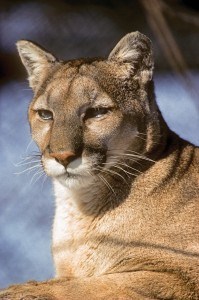
Parks Canada has collared both of the juvenile cougars seen skulking around the townsite the past six weeks and has relocated one of them to the east end of the park.
Both cougars are male and are believed to have been recently released from their mother’s care. Parks collared the first animal on Dec. 16 and set it free, in order to use the collar to track its sibling.
“We were basically using the first [cougar] to locate the second one,” explained Steve Malcolm, a human wildlife conflict specialist for Jasper National Park.
The second cougar was collared Jan. 2 with the help of a specialized dog team and has since been relocated.
The cougar hounds were able to tree both cougars that day, but there wasn’t enough time to process and relocate them both.
“We just kind of ran out of time,” said Malcolm. “We would have liked to actually capture them both and put them in the traps and relocated both of them at the same time, but it takes about four hours to process an animal from the ground all the way up to the trap and the relocation is probably another couple of hours, so it takes a little bit of time.”
Because the remaining cougar has a collar, Malcolm said it’s now just a matter of waiting for the optimal weather conditions to tree it, tranquilize it and relocate it.
“We’re just waiting on weather. It’s a little risky immobilizing animals in these kinds of temperatures, so we’re just kind of waiting for the weather to break.”
The two juvenile cougars have been causing quite a stir in town, showing their faces everywhere from the dog park to the old high school site. But, until Dec. 22, they hadn’t caused any trouble.
It was that evening that an American tourist took his dog for a walk up Old Fort Point, in hopes of taking photos of the sunset. His dog was off leash, so as he was descending the hill, he turned to keep an eye on it and when he did, he caught a glimpse of a cougar.
“He started to yell and scream at it and the cougar pounced on the dog,” said Malcolm, who interviewed the man following the incident. “It actually flattened the dog, but didn’t bite him—because I think the guy was yelling so much that he sort of caught his attention—and then [the man] ended up running over there and kicking the cougar.”
Malcolm said he can’t be 100 per cent sure which cougar it was, but he said the fact that the dog survived is a good indication that it was a juvenile cat.
“An adult would have killed the dog instantly, just because they have that skill set, and the juveniles are still skill testing.”
Malcolm said it’s nearly impossible for a cougar to differentiate between a domestic and wild animal, especially when a dog is off leash, so, he said, that’s likely why the cougar attacked the dog.
It’s out of concern for the public, as well as these young cougars, that Parks has decided to relocate the animals away from the townsite, where they can learn to hunt in an area free of human activity.
“The priority is to get the two siblings out and away from the townsite,” said Malcolm, who noted their relocation is just an acceleration of their natural process.
“Usually within first three or four months, once they get kicked out [by their mother], they usually disperse,” he said. “We’re just kind of using the relocation process as a bit of an enhanced dispersal, just to try and get them going early.”
Although the two brothers are being moved, their mother will remain near the townsite, where she has been living and hunting for many years. But, Malcolm said Parks will be collaring her as well.
“We want the mature adults hunting and living amongst the community because they tend to just focus on deer and elk and they’re good.
“The mother’s been a great asset in the community. She’s been here awhile. I’d like to keep her here. It would be nice to have a collar on her so we have a little bit more of an understanding as to her travel patterns, is she making forays into the community and such?”
Nicole Veerman
[email protected]
